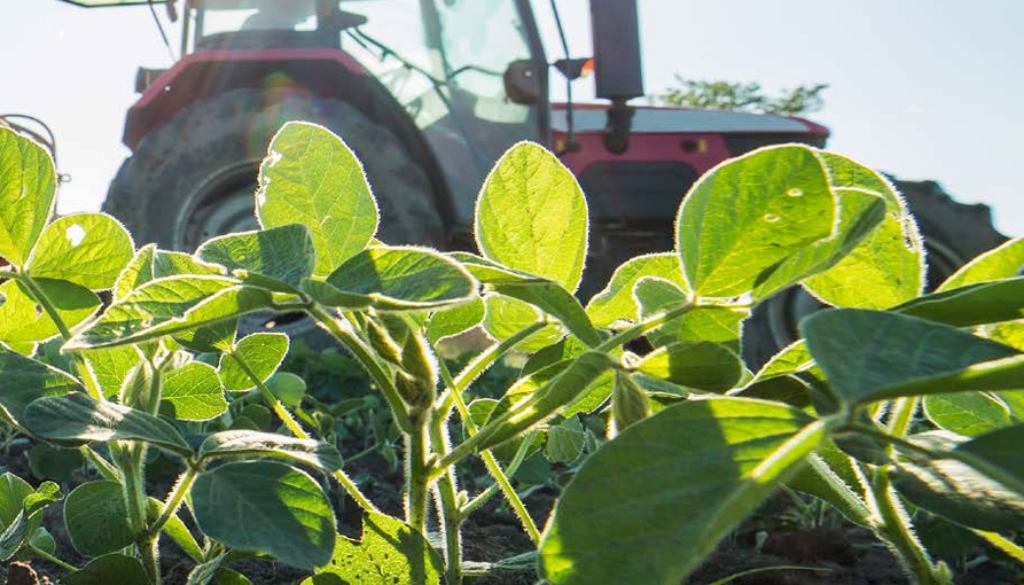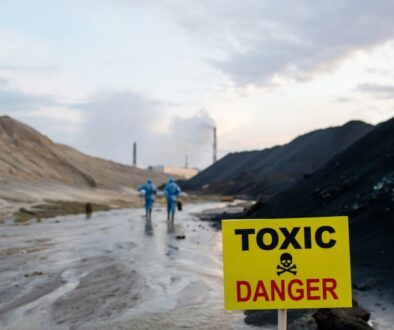An herbicide so hazardous that courts have banned it twice

By Bill Freese
In early February, something rather extraordinary happened in the world of American farming. For the second time, a federal court banned the hazardous herbicide dicamba, which has been wreaking havoc on farmers, rural communities and the natural world for seven long years. The Environmental Protection Agency (EPA) re-approved dicamba after the first court action. Will it do so once again?
What about dicamba makes it so hazardous that courts have overruled EPA twice? It’s an incredibly volatile, drift-prone weed-killer, and extremely potent as well: just one teaspoon over an acre stunts tomato plants. It vaporizes while being sprayed, but also evaporates from plant surfaces and soil days after a spraying operation. Once the vapor is airborne, it forms clouds that drift long distances to kill or injure virtually any flowering plant in its path.
And that’s precisely what happened following Monsanto’s 2016 introduction of soybeans and cotton genetically engineered (GE) to withstand dicamba’s killing effects. Widespread planting of these new GE crops triggered a dramatic upsurge in use during late spring and summer, when heat enhances dicamba’s volatility.
Dicamba has drifted rampantly from these GE fields, damaging millions of acres of non-dicamba-resistant soybeans. Wave after wave of dicamba vapor drift killed fruit trees, or left them with small, unsaleable fruit. Vegetable farms and gardens were devastated. Trees in natural areas suffered. And beekeepers reported steep drops in honey production where dicamba had devasted the flowering plants their bees require for nectar and pollen.
Echoing many of his colleagues, North Dakota pesticide expert Andrew Thostenson stated: “We are in unprecedented, unchartered territory. We’ve never observed anything on this scale since we’ve been using pesticides in the modern era.”
Center for Food Safety and scientists warned EPA about the hazards of the dicamba crop system as early as 2010, but were ignored. So we teamed up with family farmers and environmental groups to sue the agency as soon as it approved three dicamba products for “over-the-top” spraying on dicamba-resistant GE crops in 2017. That lawsuit culminated in the first court decision, which rescinded those dicamba approvals in June 2020. The 9th Circuit Court of Appeal’s emphatic ruling reflected how egregious EPA’s violations of pesticide law had been. Among six major findings, the court noted the “enormous and unprecedented damage” caused by dicamba drift, and the extraordinary fact that “EPA refused to quantify or estimate the amount of damage… or even to admit that there was any damage at all.”
Rather than accept the decision, the Trump Administration’s EPA assigned a team of 50, working overtime, to resurrect the court-rescinded products in October 2020. The pretext for re-approval was a few more studies, and a few additional control measures. The same groups sued EPA again, and after three more years of devastating dicamba damage, the second court ruling was issued on February 6th of this year.
Like the Ninth Circuit nearly four years ago, the District Court of Arizona cancelled three dicamba products. The court described how the continuing high number of dicamba drift episodes demonstrated that EPA had been wrong to put faith in the efficacy of the additional control measures introduced in 2020, and noted EPA’s continuing failure to “assess costs from offsite movement.” The Court found that EPA, in re-approving dicamba in 2020, violated the public input requirement of pesticide law. This violation was “very serious” because it deprived farmers and others of the opportunity to tell EPA about the damage they incurred from dicamba drift, which could have altered the Agency’s 2020 decision on whether not to re-approve, and if so under what conditions.
What will happen now? Well, EPA has issued an “existing stocks” order that permits “millions of gallons” of the three dicamba products that had already entered commerce prior to February 6th to be applied this year, according to the (otherwise cancelled) product labels: until June 30th on soybeans and July 31st on cotton. On March 11th, Bayer applied to EPA for re-registration of its dicamba product, XtendiMax, for the 2025 season.
In making any decision for 2025 or beyond, EPA Administrator Michael Regan and his staff must finally own up to the Agency’s past errors, and account for the enormous toll dicamba has taken on rural America and the natural world.
EPA must grapple with the fates of people like the Flamm family, whose fifth-generation, southern Illinois peach and apple orchard, founded in 1888, has been hit repeatedly with dicamba drift since 2018. Dicamba curls their trees’ leaves, which fall to earth prematurely, resulting in sunburned and stunted fruit. As of 2022, the Flamms had lost $1 million in apple production alone, and as many as 6,000 trees.
Then there is Iowa farmer Rob Faux, who can no longer grow bell peppers nor rely on his farm for income thanks to devastating dicamba damage. South Dakota grower John Seward, who has seen his vegetable farm decimated several times by airborne dicamba, may be forced to give up farming as a result.
That dicamba could shut down a farm is no news to Bill Bader, whose peach orchard in the Missouri Bootheel was decimated by multiple exposures to the herbicide over years. Bader’s farm has suffered not only from airborne drift, but also from dicamba in the very rain that falls on this region.
And Arkansas beekeeper Richard Coy was forced to move his operation to Mississippi to escape the devastating impacts of dicamba drift on the flowering plants his bees require for sustenance.
All told, EPA has received reports of over 80 different types of plants damaged by dicamba in 29 states, including pepper, squash, pumpkin, cucumber, melon, peas, potato, rice, sugarbeet, peanut and grapes, among others.
Soybeans are among the most dicamba-sensitive of crops, and according to USDA, up to 15.6 million acres were injured in 2018 alone. Depending on circumstances, dicamba drift has triggered everything from moderate damage, such as the collective $7 million in lost yields incurred by 200 Minnesota soybeans farmers, to the catastrophic, exemplified by Arkansas soybeans damaged so badly by dicamba as to yield just 5 bushels per acre, versus a typical 50 bushel/acre harvest.
If Administrator Regan decides to re-approve dicamba, he would not only be affirming the rightness of putting more farmers under financial stress and out of business, but also of stymieing new farmers before they even get started. The already daunting prospect of starting a new farm is made next-to-impossible if you are unlucky enough to break ground in the Land of Dicamba. Consider the case of Brad Miller, who purchased a small farm near Greenfield, Iowa in 2021. Over the following two years, he has seen his newly planted orchard, vegetable garden, alfalfa, canola and clover come to naught thanks to dicamba drift: trees were stunted; vegetables plants did not produce; radishes, turnips and canola died; alfalfa stopped growing. Neighbors lost all their tomatoes and similar vegetables. In a complaint lodged with EPA, Mr. Miller “expressed shock that this would happen,” that “someone would be allowed to spray something … that would come onto his property and damage it.” We agree. How could EPA permit this?
These are just a sprinkling of the many thousands of cases of dicamba damage, none of them acceptable. But the impacts go still deeper. Dicamba poisons not only the air, but also farming communities. Dicamba drift damage has created deep divisions in rural America, with those who spray the herbicide at loggerheads with those whose crops are damaged by it. In the words of the Ninth Circuit, dicamba “has torn apart the social fabric of many farming communities.”
Why has it taken civil society groups filing lawsuits and court decisions to take dicamba off the market? One might have expected better from the Biden Administration’s EPA, which in March 2021 proclaimed a commitment to “scientific integrity” in regulatory decision-making. The EPA acknowledged that some important decisions had been corrupted by “political interference” during Trump’s reign, citing dicamba as an example. Despite this commitment, and a damning EPA report laying out dicamba’s many harms in December 2021, the Agency has failed to take the necessary step and cancel dicamba’s registrations. That cowardice has condemned farmers to three more years of crop damage.
I suspect EPA’s inaction has something to do with the political clout of dicamba manufacturers Bayer and BASF, as well as the many Big Ag commodity and trade groups that are joined at the hip to these companies. And not just their raw political power, but their false narratives as well.
One myth – that drift is attributable to older formulations of dicamba – is decisively refuted by state investigators, for instance in Indiana, who established that 92% of dicamba damage incidents were in fact due to the formulations approved for use on GE crops.
Similarly, the industry has sought to convince EPA that agriculture will suffer without dicamba. But nothing could be further from the truth. EPA scientists have identified dozens of alternative herbicides registered for use with soybeans and cotton, while USDA’s most recent survey of soybean farmers’ chemical use (2020) includes 53 herbicides other than dicamba or glyphosate. Farmers managed weeds before the dicamba system was introduced in 2017, and they will do so without it.
Scare stories about potential yield loss without dicamba are equally ridiculous. EPA found no evidence to support Bayer’s claim that dicamba increases yield, while impartial university field trials showed that dicamba-resistant soybeans yielded less than Roundup Ready varieties. Thus, it’s not surprising that average soybean yields have hardly budged since 2017, after growing substantially over the prior two “dicamba-less” decades.
The most perverse myth of all is that dicamba is needed to prevent the development of weeds resistant to other herbicides – perverse because it obscures the real story, which is that excessive reliance on dicamba is already driving evolution of dicamba-resistant weeds in multiple states. This development is drawing comparisons to the explosive emergence of glyphosate-resistant weeds with the widespread planting of Roundup Ready crops. The only real solution to weed resistance is less reliance on herbicides overall, and in particular abandonment of the GE herbicide-resistant crop systems that are such potent promoters of weed resistance. Greater use of cultural techniques like complex crop rotations and cover crops can also suppress weeds.
In short, the sky will not fall if EPA does the right thing and abstains from resurrecting dicamba once again.
Good things, however, would certainly follow. The legions of growers who have purchased Monsanto’s expensive dicamba-resistant soybean seeds simply to avoid crop injury, for self-protection, will regain the freedom to farm the seeds of their choice, and save money as well. Small seed firms that sell those alternative seeds will also benefit by regaining customers they lost to Bayer, which became the world’s largest seed company when it bought Monsanto in 2018. And public sector soybean breeding programs will no longer see their experimental plantings devastated by dicamba drift.
Perhaps most important, courageous farmers who dare to diversify the Midwestern landscape of corn and soybean fields by growing fruits and vegetables or keeping bees will once again be able to farm without fear of seeing their livelihoods devastated by this herbicidal menace.
(Opinion columns published in The New Lede represent the views of the individual(s) authoring the columns and not necessarily the perspectives of TNL editors.)
 EWG
EWG


